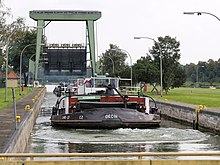Canal cross dates
The Datteln waterway cross , also known as the Datteln canal cross , is a waterway cross near the North Rhine-Westphalian city of Datteln , which connects the canals of the West German canal network . Various water authorities, companies and associations are also based there. The highlight of the property as the largest canal junction in Europe is obviously due to the then Mayor of Datteln, Horst Niggemeier , who in 1969 also launched the Datteln Canal Festival . In the meantime, the canal cross is even considered the largest canal junction in the world. In this PR context, the hit song Come along to the Dattelner Kanal (sung by Sven Olsen & the Equilis) as well as the Dattelner Kanalwasser, a Westphalian clear grain.
Waterways
Coming from the Ems and the coastal canal from the north (with a branch to the Mittelland Canal near Rheine to the east) the Dortmund-Ems Canal (DEK) runs east past Datteln to the Waltrop lock park , where it heads east and into the Dortmund city port ends. The Rhine-Herne Canal , which connects the Rhine and the navigable Ruhr from Duisburg , also ends at the lock park.
Also coming from the west of the Rhine near Wesel , the Wesel-Datteln Canal (WDK) flows through the Datteln lock and the lock port into the DEK. This is where the DEK's old journey to the north began. It is now separated by a dam in front of the historic security gate, is no longer navigable and only filled with water up to the old Olfen harbor. In the DEK north of the confluence with the WDK there is a current security gate with which the new DEK journey can be separated.
A little further south is the Datteln harbor .
Even further south, the Datteln-Hamm Canal (DHK) branches off to the east , which ends in Hamm- Schmehausen at the Westfalen power station . Here, too, there is a security gate after a few kilometers at the Waltrop farmers' association in Holthausen.
The large, contiguous water areas of the locks and ports as well as the canals with their spacious branches up to the security gates together form the Datteln Sea , which is not a "sea" in the literal sense. The length of these waterways in the city of Datteln is 17 kilometers in total. Starting from the Datteln Canal Crossing, a total of around 85 kilometers of waterways can be navigated without locks.
Drainage
The West German canal network is kept at an even level by keeping the top between the locks in Herne , Datteln, Hamm and Münster . The water level here in the Datteln waterway junction is 56.5 meters (± 15 cm) above sea level . From the Rhine, the water level in the Rhine-Herne Canal has to be raised by around 36 meters in seven and now only five canal stages (locks) and in the Wesel-Datteln Canal by around 41 meters in six stages. The Dortmund-Ems Canal is about 14 meters higher than the level in the apex posture behind the Waltrop lock park as far as Dortmund, towards the north it has the first canal step near Münster and then sinks down to the tide-dependent Ems. As far as Hamm-Schmehausen, the Datteln-Hamm Canal is about seven meters higher than the apex position by means of two locks.
Although the canals are not flowing waters, around 550 million cubic meters of water are transported in the direction of the Rhine, Ruhr and Ems each year, mainly water losses through sluices, or in other ways (e.g. through use as cooling water, seepage, evaporation) is lost to the sewer network. Therefore, water can be fed from the Lippe at the Hamm water transfer into the Datteln-Hamm Canal and thus into the entire West German sewer network. In dry periods, water can alternatively be brought uphill from the Ruhr and the Rhine by operating the return pumping stations at the canal locks of the RHK and WDK. The remote control center for these water technology facilities is located in Datteln.
Authorities and companies
At the time of the towing monopoly (1914 to 1967), the port of Datteln was the lifting point where skippers could buy tickets for their non-motorized barges. They were then hauled by state tugs to the ports in the West German canal network.
Above the Datteln lock there is a water police station , the fire boat of the Datteln volunteer fire brigade and a branch of the Duisburg-Meiderich water and shipping office with the depot and the remote control center, which is staffed around the clock in shifts. It not only takes care of the dewatering, but also registers all water levels, controls the locking and security gates and the weirs in Hamm (in the Lippe) and Duisburg (in the Ruhr).
The bunker ships for supplying the inland waterway operators with fuel, for example, are also located in the lock port there .
A marine equipment company is based in the former lifting point.
Other offers
In the port of Datteln there is no more transshipment, it is a resting and base port with services (waste oil disposal, drinking water supply, etc.). There is a sport boat yard, the boats of the naval comradeship and the reservists' association, and boathouses for the water sports clubs.
In addition to the waterways, the paved paths along the canal are popular routes for cyclists and walkers. Some of them run on old towpaths .
You can cycle along the Dortmund-Ems Canal Route from the Dattelner Meer to the North Sea.
From 1969 to 2017 the three-day canal festival took place every August .
Web links
Coordinates: 51 ° 39 ′ 20.6 ″ N , 7 ° 21 ′ 40.3 ″ E






